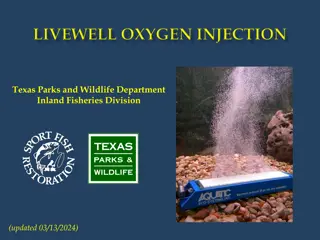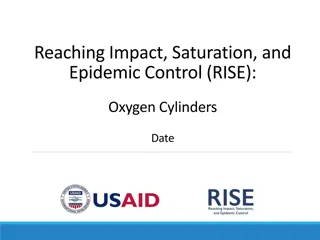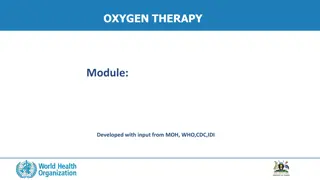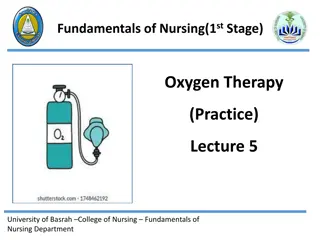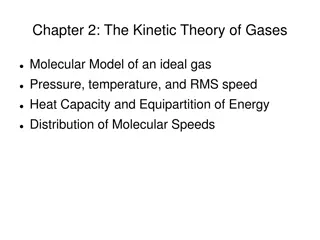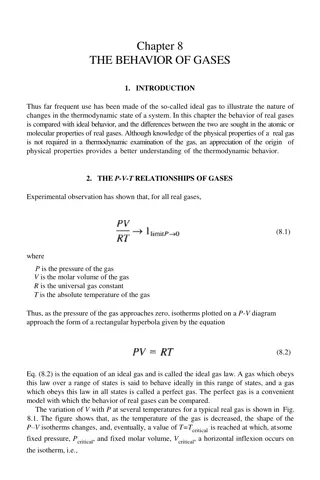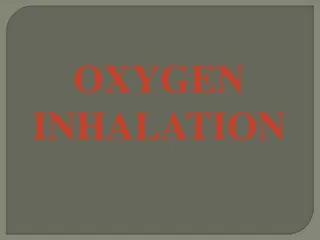Understanding Arterial Blood Gases and Oxygen Delivery Devices
Arterial blood gases (ABG) are obtained from arteries to assess acid-base balance and blood oxygen levels. The pH, PaCO2, PaO2, HCO3, and SaO2 are crucial values on an ABG report. These values reflect the blood's acid-base status, carbon dioxide levels, oxygen saturation, and more. The buffer system, PaO2 vs. SaO2, and normal ABG values provide insights into oxygen delivery and overall health. Learning about ABG values is essential for healthcare professionals to monitor and manage patients' respiratory and metabolic conditions effectively.
Download Presentation

Please find below an Image/Link to download the presentation.
The content on the website is provided AS IS for your information and personal use only. It may not be sold, licensed, or shared on other websites without obtaining consent from the author. Download presentation by click this link. If you encounter any issues during the download, it is possible that the publisher has removed the file from their server.
E N D
Presentation Transcript
ARTERIAL BLOOD GASES AND OXYGEN DELIVERY DEVICES Scott Alleshunas RRT
WHAT DO WE KNOW ABOUT ARTERIAL BLOOD GASES ? Obtained from artery Duh! Used to assess acid base status and blood oxygenation
FIVE MOST IMPORTANT VALUES ON AN ABG REPORT pH PaCO2 PaO2 HCO3 SaO2
pH Overall acid/base status of the blood due to free hydrogen ions Neutral 7.0 Acid 1----------------------------14 Base (Alkaline) 7.40 pH=HCO/PaCO2=kidney/lung
PaCO2 Carbon dioxide is the Acid side of the equation. Carbon dioxide is a normal product of metabolism. As long as cells are functioning, CO2 is produced. Like oxygen, some CO2 is dissolved directly into the plasma. The PaCO2 is the measurement of the partial pressure of carbon dioxide dissolved in the plasma. It is measured in millimeters of mercury ( mmHg ). The rest is found in the red blood cells on a hemoglobin
HCO3 Bicarbonate (HCO3) is the Alkaline side of the equation. HCO3 increases in response to high CO2. Metabolic changes take days to affect pH
BUFFER SYSTEM Carbonic Acid - Bicarbonate Buffer System - + H+ CO2 + H2O <--> H2CO3 <--> HCO3 Note: The two headed arrows indicate that the process is reversible
PaO2 vs. SaO2 PaO2is a measurement of the partial pressure of oxygen dissolved in the plasma only. It is measured in mm Hg. Only about 2% of the body's oxygen is dissolved in the plasma. The PaO2 does not tell us about the body's total oxygen content, but it does indicate how much oxygen passed through the A-C membrane to dissolve in the blood. SaO2 (Oxygen saturation) is the amount of oxygen bound to hemoglobin measured as a percentage.
NORMAL ABG VALUES pH--------------- 7.35 - 7.45 ---------- 7.4 (+/- 0.05) PaCO2------------- 35 45 ------------ 40 (+/- 5) HCO3-------------- 22 26 ------------ 24 (+/- 2) Base --------------- -2 - +2 ------------- 0 (+/- 2) PaO2--------------- 80 100 ----------- 90 (+/- 10) SaO2--------------- 94 100 ----------- 97 (+/- 3)
STEPS TO ABG INTERPRETATION 1) Determine Acidosis or Alkalosis. ---------What s the pH ? 2) Evaluate the Respiratory Mechanism. ---What s the PaCO2 ? - ? 3) Evaluate the Metabolic Mechanism. ------What s the HCO3 Changes in pH will either be: Uncompensated ( Acute ) Partially Compensated Fully Compensated ( Chronic )
Is something compensating for something else ? - , is the other moving out If you have an abnormal PaCO2 or HCO3 of normal range to try to normalize the pH? Is the pH back to normal? Is your body trying to Balance the Scale?
COMPENSATION Compensation" is the body's normal response to attempt to normalize pH By neutralizing the opposite acid base mechanism. Example: If the pH is high because of respiratory alkalosis (low CO2): Alkaline HCO3- will decrease to neutralize the pH. In this case, the abnormal bicarb is not a metabolic problem; it is a metabolic solution to a respiratory problem. It is important to determine which is the cause and which is the effect. If you treat the compensatory abnormality, you make the pH even more abnormal.
READY TO INTERPRET ABGS? Don t worry It s a breeze !!
60 Y/O PATIENT C/O DYSPNEA AND APPEARS SOB 20 AECHF GOAL IS TO KEEP SPO2 > 92% RN checked saturation and is 87% on room air. To verify this and to better assess his respiratory status an ABG was ordered pH ------ 7.48 PaCO2 -- 32 PaO2 ---- 57 HCO3 ----24 SaO2 --- 87%
60 Y/O PATIENT C/O DYSPNEA AND APPEARS SOB 20 AECHF GOAL IS TO KEEP SPO2 > 92% What O2 delivery device would you recommend ? Nasal Cannula ? Liter flow Max. liter flow for nasal cannula is 6 L/min. FiO2 ? Humidity must be provided for flows > 3 L/min. Considered a low flow device.
60 Y/O PATIENT C/O DYSPNEA AND APPEARS SOB 20 AECHF GOAL IS TO KEEP SPO2 > 92% Maybe a Simple Mask ? Not used often on floors Mainly in PACU Liter flow is 6 liters to 10 liters FiO2 35-55% *** Please do not wean liter flow below 6 liters as adequate flow is needed to wash out patients exhaled CO2 ***
60 Y/O PATIENT C/O DYSPNEA AND APPEARS SOB 20 AECHF GOAL IS TO KEEP SPO2 > 92% SpO2is now 89% on nasal cannula at 6 L/min What now ? Venturi Mask @ 50% - 15 L/min. FiO2 range is 24 50% Device will tell you the exact liter flow for a given FiO2. A high-flow device No humidity Notify the physician
60 Y/O PATIENT C/O DYSPNEA AND APPEARS SOB 20 AECHF GOAL IS TO KEEP SPO2 > 92% SpO2is now 90% on 50% Venturi mask What now ?? Non-rebreather Mask 2 flap type are used on the Med/Surg floors. 3 flap type are for ICU and ECC only. Maintain adequate flow to keep bag at least inflated during inspiration ( typically 10-15 L/min ). FiO2 ?
60 Y/O PATIENT C/O DYSPNEA AND APPEARS SOB 20 AECHF GOAL IS TO KEEP SPO2 > 92% Now you check the patient and they are breathing much easier, SpO2 100% on 3 flap NRB. To verify this the physician orders a repeat ABG: pH ------- 7.42 PaCO2 --- 37 PaO2 ---- 280 HCO3 -----24 SaO2 ---- 100%
60 Y/O PATIENT C/O DYSPNEA AND APPEARS SOB 20 AECHF GOAL IS TO KEEP SPO2 > 92% It s time to be a weaner ! Take the center flap off Now it s a Partial Re-breather FiO2 ? Wean to Venturi mask Wean to Nasal cannula
TRACHEOSTOMY PATIENTS Please contact your Respiratory Therapist anytime a trach patient is admitted to your unit. Humidity must be provided for every tracheostomy patient. Ballard suction catheter and cold aerosol set up provided per Respiratory. Suctioning is RN/RRT responsibility as a team. Trach care is RN s responsibility ( except at Michigan campus )
70 Y/O PATIENT WITH AECOPD. THEY ARE USING ACCESSORY MUSCLES AND PURSED-LIP BREATHING. GOAL IS TO KEEP SPO2 88 - 92% AND TO DECREASE THEIR WOB. They are already wearing a nasal cannula at 4 L/min. To assess their respiratory status an ABG was ordered: pH ------- 7.30 PaCO2 --- 62 PaO2 ---- 62 HCO3 ----- 31 SaO2 ----- 90%
70 Y/O PATIENT WITH AECOPD. THEY ARE USING ACCESSORY MUSCLES AND PURSED-LIP BREATHING. GOAL IS TO KEEP SPO2 88 - 92% AND TO DECREASE THEIR WOB. High-flow Nasal Cannula Flows from 20 60 L/min Creates some ( ? ) CPAP Flushes out the deadspace
70 Y/O PATIENT WITH AECOPD. THEY ARE USING ACCESSORY MUSCLES AND PURSED-LIP BREATHING. GOAL IS TO KEEP SPO2 88 - 92% AND TO DECREASE THEIR WOB. HFNC is applied at 40 L/min with FiO2 35% The patient appears more comfortable. Let s check an ABG: pH ------- 7.37 PaCO2 --- 52 PaO2 ---- 68 HCO3 ----- 31 SaO2 ----- 91%
Rock on !! Questions ?






